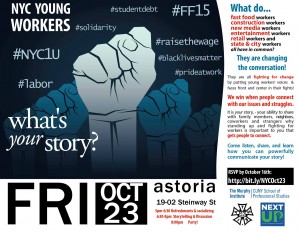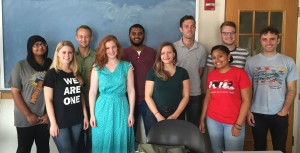By Carey Garrison
This Friday, October 23, the Central Labor Council’s Young Workers will be hosting a fun yet educational event that promotes storytelling as a powerful way of accomplishing change. The event invites young workers (18-35) to come out Friday between 5pm to enjoy refreshments and socializing, followed by a well-developed educational portion at 6:30pm that breaks down the essentials of storytelling and encourages interaction and discussion, followed by a party and an opportunity for continued discussion at 8pm. From my experiences working with the CLC Young Workers, this event is going to be a uniquely fun yet engaging experience for young workers. But the question then becomes—why? Why young workers, why select such a particular demographic to represent and engage workers, what makes this group of individuals unique?
As a millennial who is new to the labor movement, I see potential in engaging the younger generations to accomplish change for all. Sure, my generation is often criticized for the overuse of technology, the inability to commit and settle down, and the futile combination of ideological views with political apathy; but I think that behind these negative stereotypes, millennials have plenty to bring to the table.
I feel that the most important distinction of millennials in the workforce from the older generations is the diversity of workers. Millennials are the most diverse generation in the workforce based on categories such as race, ethnicity, gender, sexual orientation, educational background, family structure, and more, Additionally, whereas the use of technology may be deemed deconstructive by older generations, we find technology to be constructive. In an instant, we can take the news of an incident, create a hashtag, and post to social media, quickly getting the who world talking about something that might otherwise be considered local news, but that is really powerful in the cause for which we are fighting.
Millennials find ways to utilize the differences among us to find the strengths between us, all the while relying on technology as a vital way of sharing and communicating instantaneously. But what does this mean for young workers? Why is this important, and where does storytelling come into play? In my opinion, if we can encourage young workers to share their stories with one another, the possibilities are endless. I would argue that the desire for social justice among young workers is evident, but that the action toward change should be strengthened. Through storytelling, we can get young workers sharing both in their communities and at work, utilizing the power of talking, texting, and social media, to eventually solidify more as an integral part of the workforce that is dedicated to changing labor for all generations of workers, both now and in the future.
So what’s your story? Come to the event Friday in Astoria to listen, share, and learn about how you can powerfully communicate your story. I hope to see you all there!
RSVP on the Facebook page here.
Casey Garrison is a current Union Semester student from Hendrix College in Conway, Arkansas. He is interning with the International Brotherhood of Electrical Workers Local 3, based in the historic New York neighborhood of Flushing, Queens. Local 3 has been an active participant in the New York City Central Labor Council’s development of young worker committees and so it’s fitting that Casey has been helping to organize and promote young worker union organizing.
Casey, second from the right, back row, with classmates.




